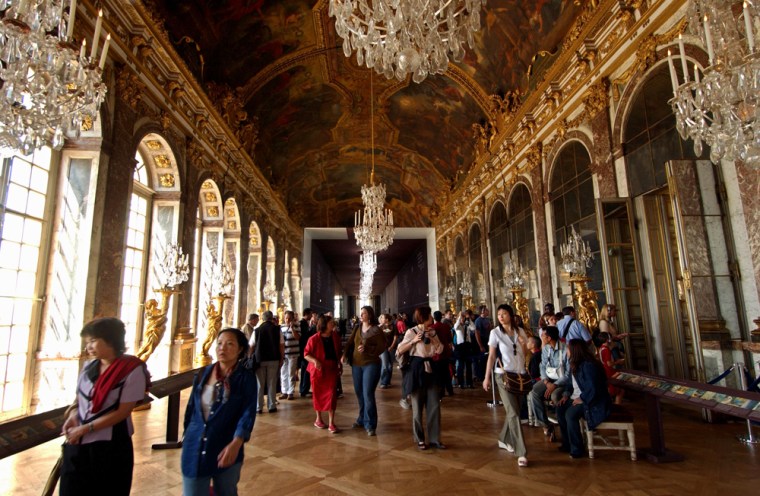At last, the Hall of Mirrors is again fit for a king.
Workers at the Chateau of Versailles are putting the finishing touches on a three-year, $15.6 million renovation of the gilded gallery of 357 mirrors where King Louis XIV entertained — and intimidated — diplomats and courtiers.
The hall’s grand reopening will likely come sometime in June. For now, the scaffolding is still up, and buckets, sandpaper and brushes are stacked up on makeshift shelves. Yet already it’s clear just how much of the original splendor has been restored.
The vaulted ceiling is especially astonishing. Before the renovation, Charles Le Brun’s overhead paintings — marking important moments in the Sun King’s reign — were dark and faded, and visitors rarely looked up. Skies that were supposed to be sunny blue were a ghoulish green. Details were lost, covered over by grime, darkened varnish and overzealous restorations of the past.
Now, a pair of chubby children playing cards is visible again. In another panel, restorers revived a strand of pearls in a treasure chest, a detail that was masked over in the 19th century.
Past restorers often peeled the panels off the ceiling so they could restore them more easily, but that had devastating consequences. Sometimes, when they put the paintings back up, pieces were patched into the wrong place.
“Pulling them down meant there were always rips, and that made the sky look like a patchwork,” said restorer Veronique Stedman. This time, her team worked with a light touch, trying to keep touchups to a minimum while restoring the overall harmony.
The ceilings are an allegory of absolute power — a muscular Louis XIV appears wearing gold Roman body armor, while France’s one-time enemies were bashed with visual jokes. Germany, for example, is depicted as a woman sitting on a cloud, a metaphor for a regime propped up by hot air.
“It’s almost a work of propaganda,” said Petronille Eynaud de Fay, an official in charge of sponsorship for Vinci, the French construction company that funded the renovation. Private patronage is much more common in France’s traditionally state-reliant art world since a 2003 law giving companies more tax incentives to do so.
The 960-square yard Hall of Mirrors, built between 1678 and 1684, is the chateau’s centerpiece, adorned with massive mirrors at a time when even the tiniest hand mirror was expensive. It is rich in history: The Treaty of Versailles that ended World War I was signed here on June 28, 1919.
But the Galerie des Glaces, as it is known in France, faced problems right from its start. Craftsmen first had to do touchup work 15 years after the hall opened, in part because of smoke from candles. The most recent renovation came soon after World War II.
During the new restoration, mirrors were taken down to be reinforced, and some were replaced with historic period mirrors. Workers also put in a new parquet floor and touched up marble and gilding. The hall was never completely shut to visitors — workers renovated one half, then the other, so tourists could always get a sense of the gallery.
Restoration teams uncovered some surprises. They found that one restorer from the past carved his name into Le Brun’s painting. His autograph reads: “Charles Closier, 1864, age 22.” That gave teams clues about an 1864 restoration of which they knew little.
And when workers pulled down the mirrors and looked behind them, they found historic graffiti. One past worker at Versailles, presumably venting about all his hard work, even drew a caricature of his boss.
